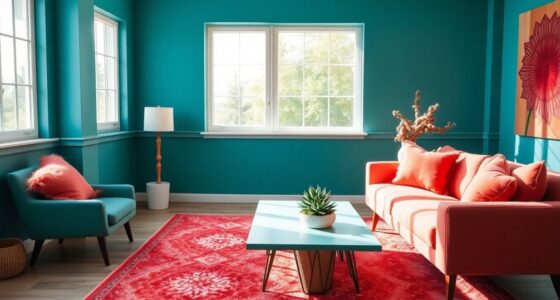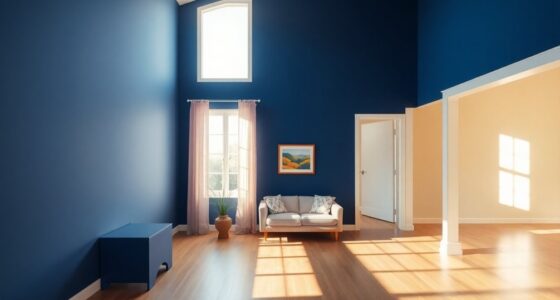Choosing colors can greatly impact your mood and productivity. Warm colors like red and yellow boost energy and creativity, while cool shades like blue and green promote calmness and focus. If you're looking to energize a workspace, bright colors work best. For spaces like bedrooms, calming hues are ideal. Combining colors thoughtfully can enhance emotional responses and increase motivation. Discovering which combinations work best can lead to a more balanced and productive environment.
Key Takeaways
- Warm colors like red and yellow stimulate energy and creativity, making them ideal for collaborative spaces.
- Cool colors such as blue and green promote calmness and focus, suitable for offices and bedrooms.
- Bright colors can elevate mood and motivation, enhancing productivity in high-activity areas.
- Neutral colors provide balance, allowing for vibrant accent colors to stand out without overwhelming the space.
- Combining blue and green fosters a calming environment, while red and yellow boost energy and collaboration.
The Impact of Color on Mood and Behavior
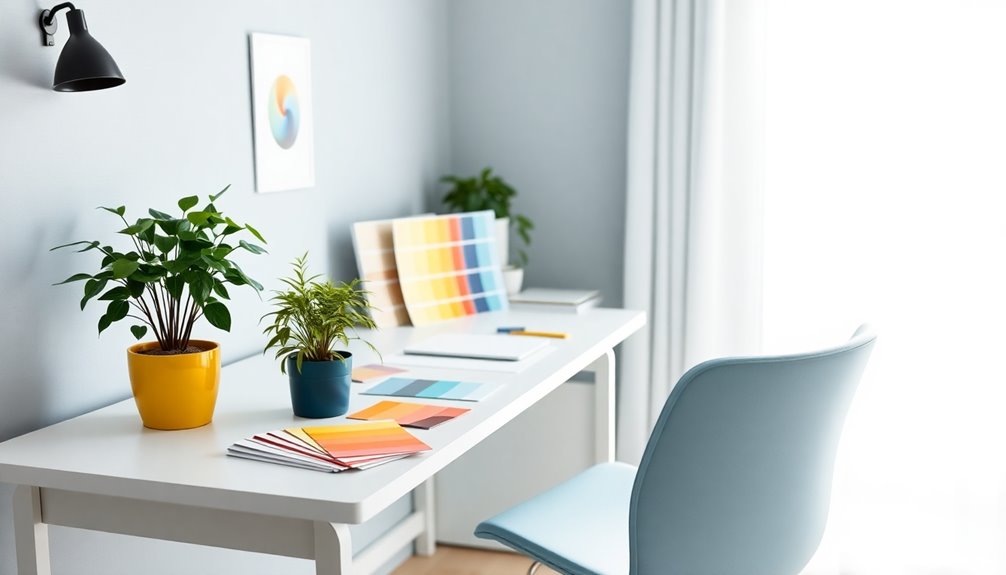
When you consider how colors influence your mood and behavior, it's clear that they play a significant role in your daily experiences.
Color psychology reveals that warm colors like red and yellow can stimulate energy and creativity, making them ideal for high-activity spaces such as offices and kitchens.
Conversely, cool colors like blue promote calmness and focus, enhancing productivity, especially during administrative tasks.
Green, associated with balance, fosters a calming atmosphere that reduces feelings of overwhelm.
Bright colors elevate mood and motivation, while cooler tones alleviate stress.
Understanding Color Psychology in Design
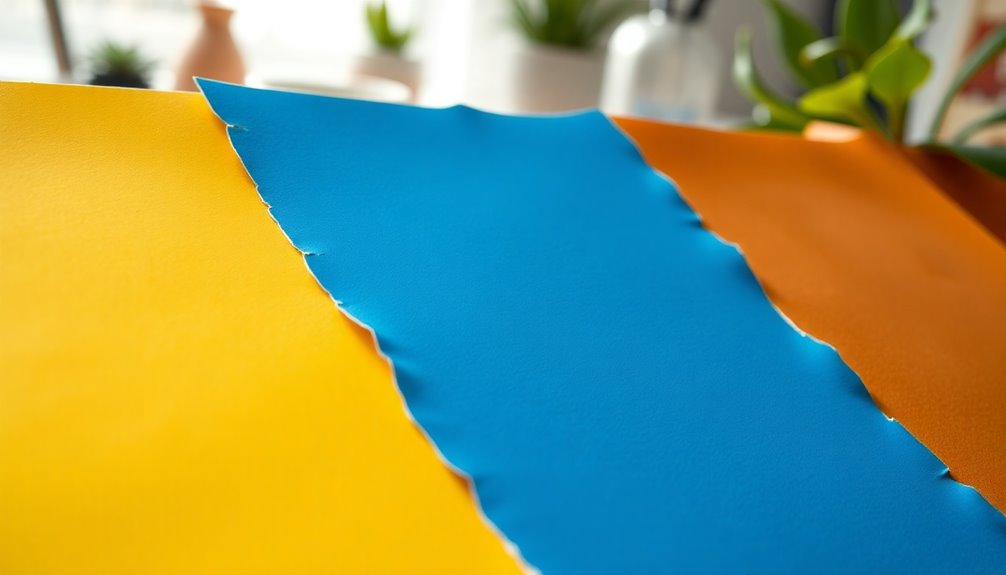
Color psychology is essential in design, influencing how spaces feel and function. Understanding which colors work best in specific environments can create an atmosphere that boosts creativity and productivity.
For instance, bright, stimulating colors like yellow and orange can help get your creative juices flowing in collaborative spaces. In contrast, natural colors such as blue and green promote a sense of calm, enhancing focus and reducing stress.
By incorporating color thoughtfully, you can tailor the environment to meet varying needs. Research shows that integrating specific colors into your design can lead to improved employee productivity and satisfaction, creating a more positive atmosphere overall. Additionally, using warm color palettes can enhance the overall mood of a space, making it feel inviting and comfortable.
Choosing the right colors can make all the difference in how you and others experience a space.
Benefits of Choosing the Right Colors
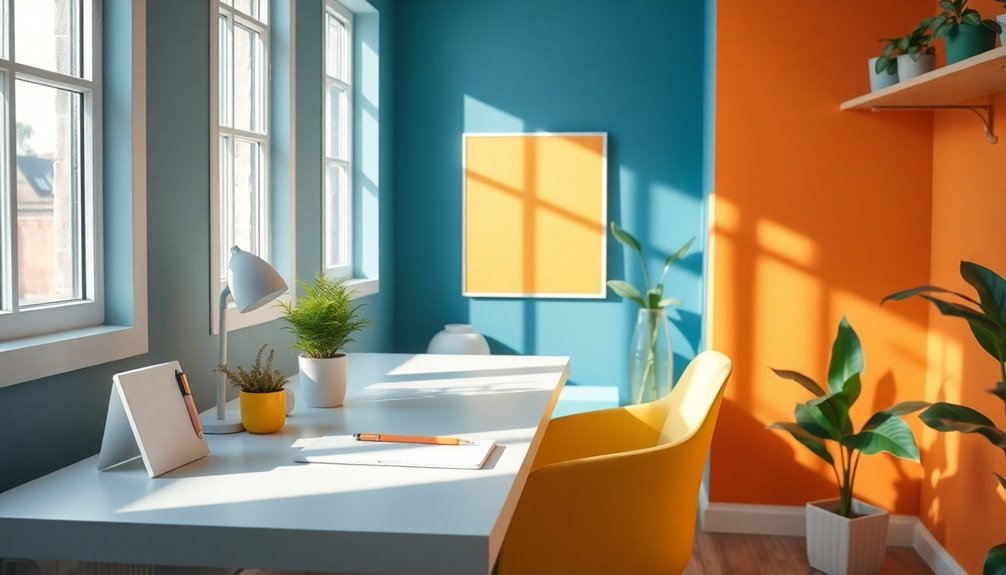
Selecting the right colors can transform a space and greatly impact your mood and productivity. Colors play an essential role in your emotional responses and can enhance creativity, communication, and overall well-being in workspaces.
| Color | Mood Impact | Productivity Boost |
|---|---|---|
| Red | Energy and enthusiasm | Increases alertness |
| Blue | Calm and focused | Enhances concentration |
| Green | Relaxation and balance | Reduces eye strain |
| Yellow | Optimism and creativity | Stimulates innovative thinking |
Incorporating calming colors like blue and green helps lower stress levels, while warm colors like yellow can spark creativity. Ultimately, the right color choices can create a positive atmosphere, fostering collaboration and satisfaction in your workspace. Additionally, creating a calm environment can be just as important as choosing the right colors, as it enhances overall well-being.
Practical Tips for Incorporating Color in Spaces

Transforming your space with color can be a simple yet powerful way to enhance your environment and mood.
To energize high-activity areas like kitchens and living rooms, incorporate bright, warm colors such as yellow and orange. For bedrooms and offices, use calming colors like blue and green to promote relaxation and boost productivity.
Neutral colors, like white, gray, and brown, can create balance while allowing accent colors to shine. Utilize decorative items like pillows and rugs to easily change your color scheme without the hassle of repainting.
Remember the psychological effects of color intensity; saturated colors can energize, while muted tones provide a soothing atmosphere, ultimately influencing your mood and productivity. Additionally, consider how color psychology can play a significant role in your overall design strategy.
Color Combinations for Enhanced Productivity and Well-Being

When it comes to enhancing productivity and well-being, the right color combinations can make a significant difference in your workspace. Here are some effective pairings to contemplate:
| Color Combination | Benefits |
|---|---|
| Blue & Green | Creates a calming atmosphere for relaxation and focus. |
| Red & Yellow | Stimulates energy and motivation for collaboration. |
| Neutral Colors + Vibrant Shades | Balances productivity without overwhelming sensations. |
Incorporating natural colors like earthy greens can boost cognitive performance during long hours. Meanwhile, soft blues paired with energizing yellows evoke optimism while maintaining a serene environment. Additionally, incorporating elements of smart bathroom technologies can create a more comfortable and efficient workspace. Choose your colors wisely to optimize your space for enhanced productivity and well-being!
Frequently Asked Questions
How Does Color Affect Mood and Productivity?
Color affects your mood and productivity in various ways. When you're surrounded by vibrant colors, you might feel more energized and motivated.
Conversely, softer, muted tones can create a calming atmosphere, helping you relax and focus. For example, you might notice that red boosts your attention to detail, while blue helps maintain your concentration.
What Color Encourages Productivity?
If you want to encourage productivity, consider using blue in your workspace.
It's known for enhancing concentration and mental clarity, which can help you stay focused on tasks.
Red can also be effective, especially for detail-oriented work, as it boosts attention to specifics.
Meanwhile, yellow might spark creativity and optimism, while green fosters relaxation, reducing strain during long hours.
Each color can play a unique role in creating an environment that supports your productivity.
What Is the Best Color Background for Productivity?
When you're considering the best background color for productivity, think about what tasks you'll be tackling.
Blue can help you concentrate and feel calm, perfect for focused work.
Green promotes relaxation, reducing stress during long projects.
If you want to boost creativity, yellow's energizing vibe might be just right.
For tasks that need precision, red can sharpen your attention to detail.
Choose a color that aligns with your specific goals and preferences.
How Can Color Affect Mood and Even Productivity in an Office?
Color greatly impacts your mood and productivity in the office. When you surround yourself with blues, you'll likely feel more focused and clear-headed.
Warm colors like red and yellow can energize you, sparking creativity and motivation during brainstorming sessions.
Meanwhile, greens create a calming atmosphere, reducing stress and enhancing concentration.
Conclusion
Incorporating the right colors into your environment can greatly boost your mood and productivity. By understanding color psychology, you can create spaces that inspire creativity, calmness, or focus. Experiment with different shades and combinations to find what resonates with you. Remember, it's not just about aesthetics; it's about crafting an atmosphere that enhances your well-being. So, take the time to choose colors wisely, and watch how they transform your daily experiences for the better!




